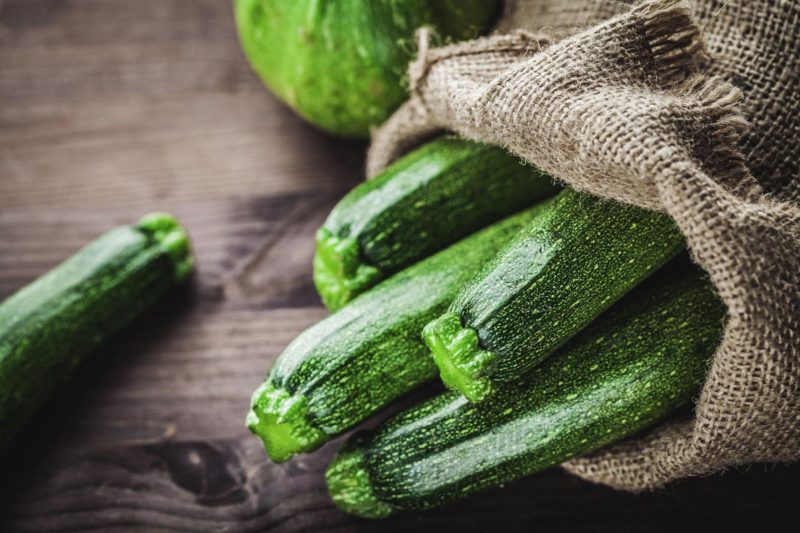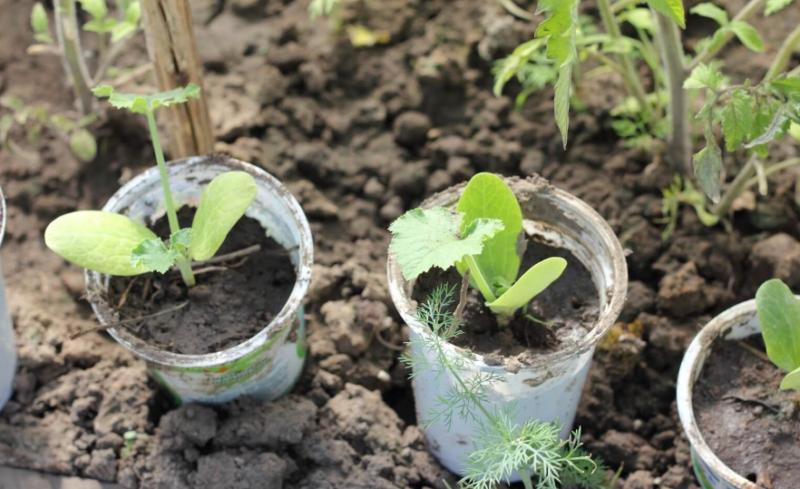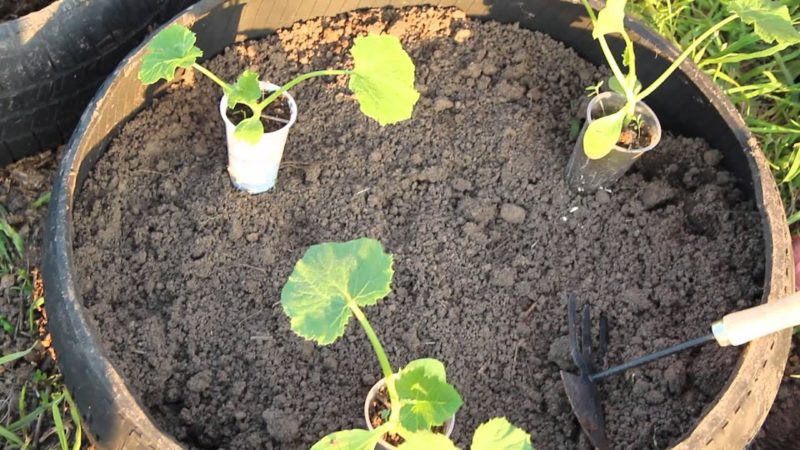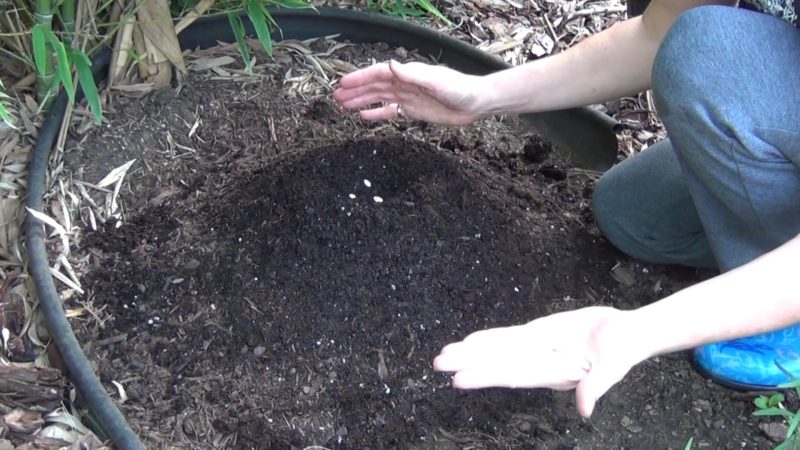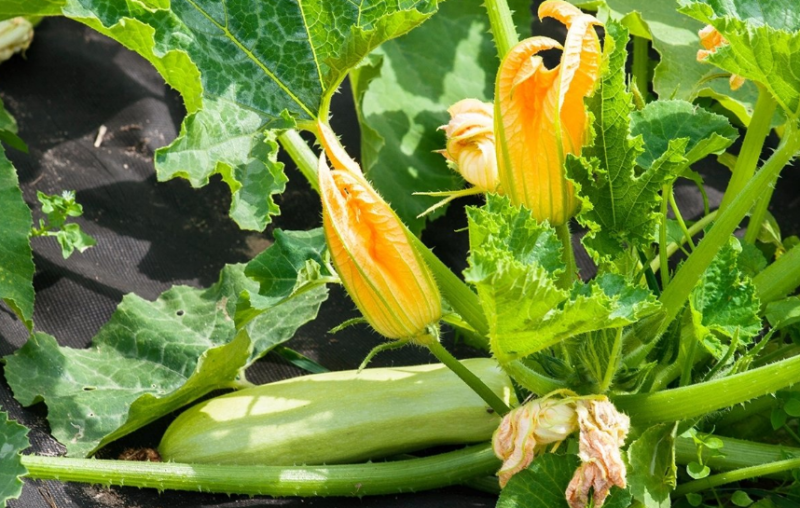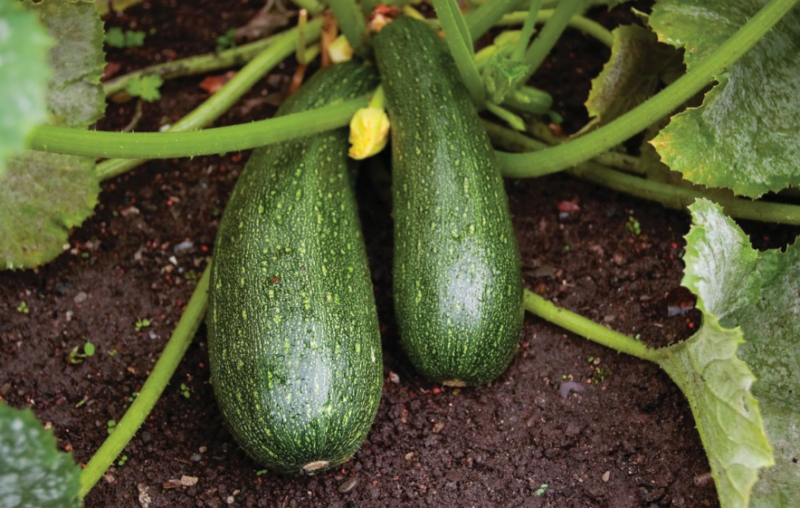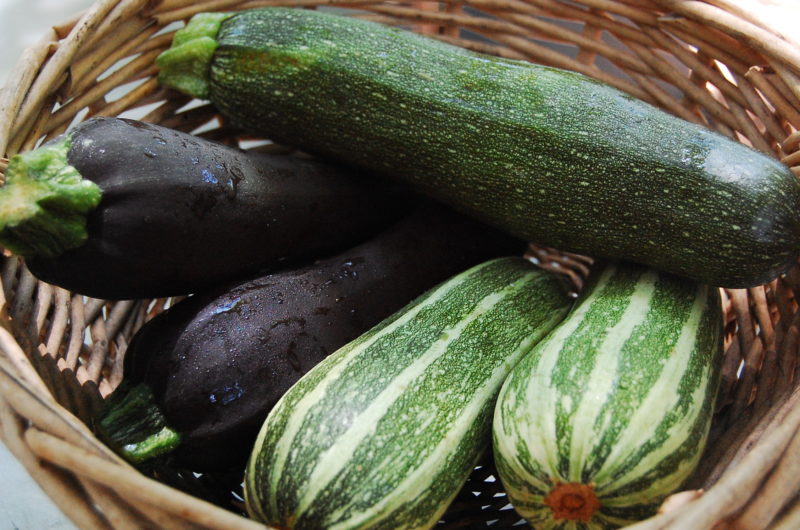Among the vegetables on our tables, one of the most popular is zucchini. This garden crop is a source of many useful substances, while remaining a dietary product. Many summer residents know the unpretentiousness of zucchini, planting and care in the open ground for which do not require much effort. Let us consider in detail the main points and features of its cultivation and storage.
Material Content:
Description of varieties of zucchini
It is difficult to find a vegetable that could compare with zucchini in the number of types and forms of ripe fruits.
Here are just a few of them:
- "Cavili." The variety belongs to the parthenocarpic variety (capable of self-pollination). Bred a hybrid in the Netherlands. Differs in high productivity and early ripening. The fruiting period reaches two months. The period from the appearance of the first seedlings to the formation of a mature fetus is 41 days with a slight deviation in both directions. The vegetable has an elongated cylindrical shape (length - about 20 cm), a light green color and a very delicate pleasant taste. The finished product can be consumed fresh or used for conservation.
- Iskander. Another Dutch variety that belongs to the early ripening species. The time to complete ripening is approximately 1.5 months. The hybrid is high-yielding and hardy. Fruits are tied even at low temperature values.The plant itself is a bush with spotty foliage, varying in color from light to dark green. The shape of the fetus is cylindrical with a narrowing in the area of the stalk. The edible part has a creamy tint, dense texture and delicate taste. The pulp is used for everyday dishes and winter preservation. The plant is resistant to anthracosis and powdery mildew.
- "Aral." An early ripening variety with a ripening period of one month. The cylindrical fruits have a barely noticeable ribbing and white spots. Length - up to 15 cm, diameter - about 6 cm. This kind of vegetable finds universal application, possessing excellent taste in stewed, fried and canned form. Noteworthy is the variety and good preserved properties. Its storage period can reach 4 months.
- "Black handsome." A mid-early plant with a fruit ripening period of about 50 days. Differs in compactness and plenty of foliage. From one bush you can get up to 5 zucchini. The vegetable is a dark green shade of a cylindrical shape. The fruits are very smooth to the touch. The texture of the pulp is tender, the taste is unsweetened. This hybrid has universal application as the previous types.
- "The best". The maturity period is, on average, 43 days. Shrub plant suitable for greenhouse cultivation and in the open ground. The cylindrical fruits have an orange color and a diameter of up to 8 cm. The length is up to 30 cm. The edible part is also yellow-orange with a pleasant delicate taste.
- "White-fruited". This result of domestic selection is characterized by early maturity, resistance to bacteria and good keeping quality. Fruits in the form of white cylinders have a thin skin and pulp of medium density with a delicate taste.
- Tsukesh. The ripening period is about 45 days. A bush plant with a characteristic compact arrangement produces fruits weighing up to 900 g with a thin green peel in small specks. Thanks to its texture, crispy flesh is ideal for pickling and pickling.
- "Kid". Early ripe type of white-fruited zucchini with delicious delicate pulp, recommended for diet menus and baby food. This kind of vegetable loves light and warmth, so it dies at the slightest cooling. Productivity reaches up to 1 kg per square meter.
- "Roller". It has a short ripening period (on average, up to 37 days) and a plentiful harvest. Oval fruits with a light green color are filled with loose flesh with a pleasant taste. It tolerates long-term storage.
- "Orange". An extraordinary variety, characterized by an exotic type of fruit. They are bright round, are present in large numbers on one bush. They should be collected in diameter up to 15 cm. In this form, the vegetable retains a sweet taste and is suitable for use in raw form.
Choosing the seeds of a suitable variety, you can plant them and wait for the first shoots to appear.
Growing seedlings of zucchini from seeds
Before planting seeds, they must be processed in accordance with the following instructions:
- mechanical preparation;
- disinfection;
- hardening;
- placement in a solution with trace elements;
- germination.
If all important points are observed, then the first sprouts appear after 3 days.
The timing of sowing seed is calculated based on the estimated date of planting in open ground. Using purchased seeds, it is enough to follow the recommendations on the packaging. If material taken from own fruits is taken, then the sowing date should precede the day of planting by 3-4 weeks.
Usually, the beginning of the process occurs in mid-April, repeating after 3 days, so that the mature shoots have different ages. This approach guarantees a stable crop during the summer period.
In the store you can buy ready-made earth mix.
At home, it is made by combining:
- 5 kg of peat;
- 1 kg of turf land;
- 200 g of wood ash;
- 300 g of river sand;
- 2.5 kg of humus.
After forming the proper foundation, it's time to start planting the seeds.
- It is necessary to prepare containers, which are suitable for ordinary juice boxes or special peat pots.
- Seeds are placed in moist soil to a depth of 4 cm with the pointed end down. One container is designed for one seed.
- After that, the material is watered and aged at 28 degrees until the first sprouts appear.
- Then they are placed in a sunny place at temperatures up to 17 degrees in the afternoon. As a result, the seedlings will receive enough heat to have time to grow stronger before active growth.
- For further development, they should provide a temperature regime that includes 22 degrees during the day and at least 16 at night.
After germination, the growth of seedlings is very intense due to the abundance of nutrients in the seeds. But after a couple of weeks there is a lack of additional food. To ensure it, it is necessary to regularly water and loosen the seedlings. Ready-made organic mixes from specialty stores are great. A week after the first approach, fertilizer should be carried out using a home-made or acquired nutritional composition. A week before planting, seedlings are fed a third time.
Due to the fact that the seedlings of this culture can hardly adapt to the growth conditions in the open ground, it is necessary to harden it.
For this, containers with sprouts are taken out to fresh air several times a day, placing them in a place protected from direct rays. Every next day, the amount of time spent on the street increases by five minutes.
When the plant can be outdoors for more than an hour, it's time to accustom it to direct sunlight, starting with one minute. Just a few days before the transplant, the seedlings are put out for the whole day, but exclusively in the shade. Thus, a gradual adaptation of young shoots to more severe conditions of open ground occurs.
How to plant vegetables on the site
This vegetable crop, despite the general unpretentiousness, still requires compliance with a number of rules when planting seedlings on the site.
Compliance with the timing and rules of landing
About 25 days after the appearance of the first seedlings, the young shoots are transplanted into the open ground.
- The distance between the bushes should be at least 2 meters.
- Wells before placing the plant should be properly shed.
- It is important not to separate the seedling root from the earthen coma, so as not to damage its integrity.
- Having strengthened the sprouts, it is necessary to compact and thoroughly moisten the topsoil.
- To preserve moisture, it is better to sprinkle the earth with a layer of straw.
- To protect the leaves of seedlings from the scorching sun, they can be covered with any transparent material.
Then and with what you can plant
Belonging to the pumpkin family complicates the interaction of zucchini with fellow cultures from the same group. Therefore, when planting them, it is better to avoid areas where pumpkins, zucchini and, especially, cucumbers previously grew. Violation of this rule can lead to a reduction in yield or even seedling disease.
As for the remaining vegetables, there are no strict restrictions. This is due to the undemanding zucchini, which is fueled by its own useful elements.
High yields can be achieved by placing the crop after:
- legumes;
- any greens;
- nightshade;
- Luke;
- eggplant;
- all kinds of cabbage.
Near the zucchini, it is advisable to plant clover or mustard, improving the soil composition. Also, carrots, garlic and beets can be noted as successful “neighbors”.
Due to the fact that this pumpkin culture does not tolerate drafts, sunflower or corn planted next to it will come in handy to protect it.
The most optimal place for the plant is the area on which the compost mixture was located.
The nutrients remaining in the ground will provide an ideal nourishment for the young roots of seedlings. It is permissible to use the same place for planting zucchini no more often than once during 5 years.
What should be the soil
Soil for planting this vegetable is prepared since the fall.
For successful crop cultivation, the following types of soil composition are suitable:
- Peaty. You can make it by mixing a square meter of land with 10 kg of humus. As a mineral additive, wood ash or potassium sulfate is taken.
- Sandy. It will require abundant fertilizer by mixing with turf soil. Humus with manure will do. To get a good harvest, additional growth promoters come in handy.
- Clay For loosening this soil, dry sawdust and peat will be needed. You can add mineral dressing in the form of wood-type ash.
- Chernozem. This fertile soil type should be supplemented with sawdust, ash and superphosphates. It is important to achieve the necessary friability of the earth.
After planting the crop in an optimal place and supplying it with the necessary nutrients, it remains to provide the plant with proper care.
Read also:decorative cabbage
All the secrets of caring for zucchini in the garden
To obtain a rich harvest of healthy fruits, it is important to adhere to the main aspects of growing zucchini in the open field.
Suitable temperature
This vegetable loves heat, but easily tolerates minor temperature fluctuations. But freezing can lead to his death. The optimal indicator is about 20 degrees above zero. It is necessary to protect the plant from direct sunlight.
Proper watering and handling
Possessing a developed root system, zucchini can easily tolerate periods of drought, unlike other pumpkin crops. However, he needs constant abundant watering due to evaporation through the leaves and accelerated ripening of the fruits. With a lack of water, the quality of the resulting crop suffers. The optimum degree of humidity is 70%.
Fertilizing, fertilizing and cultivating
- Even before the first flowers appear, it is necessary to feed with a mixture of chicken manure, nitrophoska and water. A liter of composition will be required on the bush.
- After flowering begins, wood ash and Efekton, taken in 30 g each, are used as fertilizers. They should be diluted with water to 10 liters of the finished composition.
- During the ripening period, top dressing is similar to the previous method. This increases the amount of substance per bush (2 liters).
Loosening the soil under the plants should be regular, avoiding the formation of a dense earth crust on the surface.
How to pinch vegetables
On the climbing zucchini, the top is pinched after the fourth sheet. As soon as the main stem reaches one meter in height, it should be removed.
Shrub species is not subjected to such processing. The main thing is to see that the foliage does not grow much. If necessary, several leaves should be cut off in the middle of the bush.
Pest and Disease Control Methods
The main pests include:
- melon aphids;
- whitefly;
- spider mite.
Of the most typical diseases, the following are especially distinguished:
- Powdery mildew - is a fungus that affects the stem and leaves.
- Anthracnose - usually appears during the growing season.
In order to prevent diseases and attack pests, it is necessary to comply with the principle of alternating plantings, as well as timely remove the affected leaves and fruits.
A diseased or damaged plant should be treated with Confidor or Karbofos. Mullein or hay infusion, as well as colloidal sulfur, are very effective.
From folk recipes, onion tincture can be distinguished, which is prepared with the addition of pepper and water. The healing properties of hot pepper are also known. It is poured with warm water, then liquid soap and ash are added.
Harvesting and storage
The fruits of this culture ripen very quickly. But here everything is individual and largely depends on the variety. Usually, from the appearance of the first flowers to the harvest takes about two weeks. You should focus on the size of the vegetable. If it has reached 15 cm, then it is already ready for use.
- Before laying in the cellar, fruits should not be washed so as not to violate the natural protective coating.
- For some time, zucchini should be in the sun to destroy the dangerous pathogens of fungal diseases.
- Next, the vegetables are sent to the net, which can be hung or placed on a shelf in the cellar.
- For long-term storage, the selected room should be cool and ventilated.
- The main enemy of the zucchini is moisture. Therefore, it is important to cover the blanks with dry foliage or straw and constantly monitor their condition.
If you follow all the rules, you can enjoy fresh vegetables from your own garden all winter.
What problems can you face when growing
The main difficulties are associated with the increased acidity of the soil, in which the fruits are often sick. It is neutralized with slaked lime or chalk. It is also worth worrying about a high level of water in the ground, making beds with a large rise. As with many plants, zucchini are fatal due to a lack of light and heat, as well as a sharp cooling. It happens that the fruits are not tied due to lack of pollination. In this case, you need to attract insects with sugar or honey. If all conditions are met, and the growth of the culture leaves much to be desired, then the neighborhood and the alternation of vegetables, as described above, are violated.
Caring for zucchini is quite simple. It is important to remember the features of the vegetable and several key points of its cultivation in order to get a rich harvest of healthy and tasty fruits.


